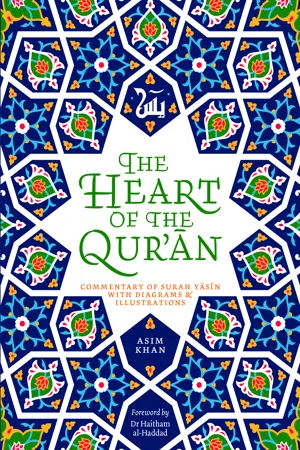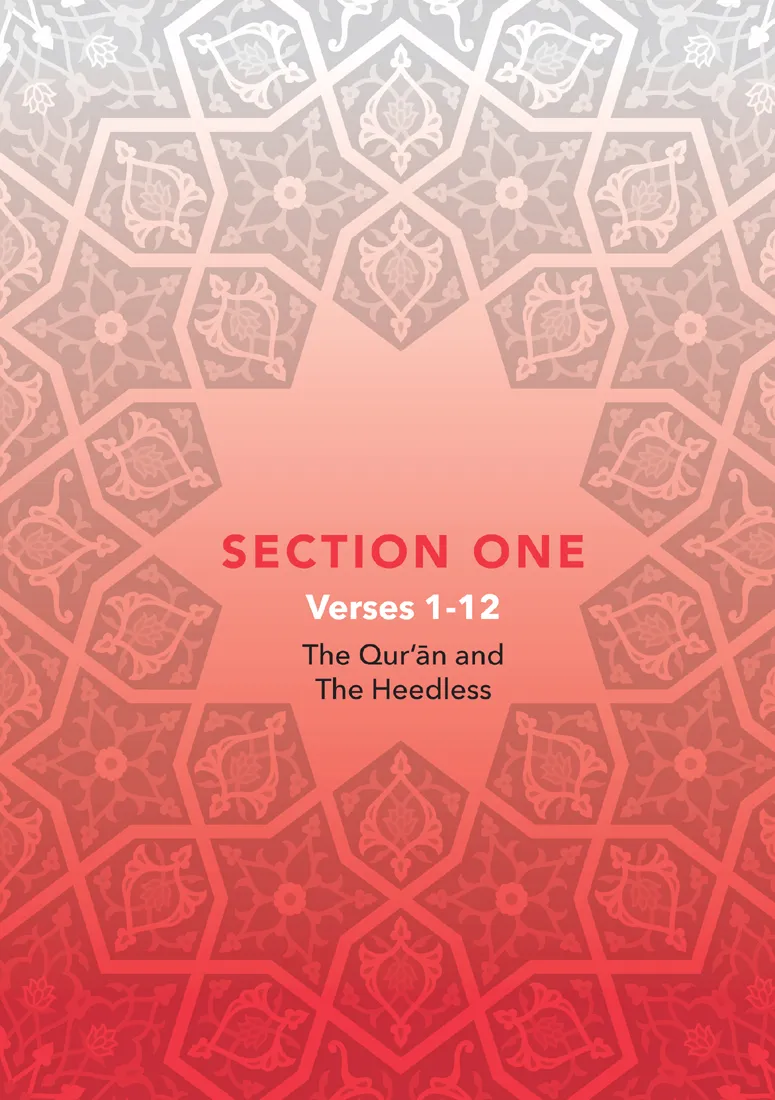![]()
Section One : Verses 1-12: The Qur’ān and the Heedless
يسٓ ١
1 Yāsin
The Arabic letters yā' and sīn are among the disjointed letters (
al-muqatta'āt) that are found at the beginning of twenty-nine Surahs and whose meaning is considered by most to be known only to Allāh. Some posit that Yāsīn may be an abbreviation meaning “O human being”.
14 This was the view of the great Companion Ibn ‘Abbās. In this interpretation, the yā' is the vocative “O,” as used in many Qur’ānic verses, and the sīn is an abbreviation for
unaysīn, the diminutive of
insān (“human being”). In this context, the diminutive “O little human being” is a term of endearment from Allāh to the Prophet Muhammad
, and thus, embedded within the beginning of Yāsīn is the love of Allāh for His Messenger.
In recitation the names of the letters are used, not their sounds, hence it is recited Yāsīn and not ya sa. The Prophet
was unlettered (
ummi) whereas names of letters are only known to those who have studied how to read and write. Thus the disjointed letters are a mark of the divinity of the Qur’ān and not a product of Prophet Muhammad’s authorship.
These letters could also serve another symbolic purpose and that is as a challenge to those who reject its message. It is as if Allāh is stating that this miraculous Qur’ān is but the coming together of these letters (Yāsīn, alif lām mīm etc) that you all know of and can articulate in your own speech. Thus a challenge was put forward to mankind to try and match the Qur’ān if you can, but if you cannot, then submit yourself to it. The Arabs of that time prided themselves on being the masters of Arabic language and poetry, and hence the challenge was a fitting one.
In conclusion, one of the lessons this verse is alluding to is that this book, called the Qur’ān, is Divine speech and not human. It is showing us that though itsss exists in this world, it is by no means from it. What supports this view is the fact that throughout the Qur’ān, whenever these disjointed letters appear, the excellence of the Qur’ān is mentioned directly afterwards.15
وَٱلْقُرْءَانِ ٱلْحَكِيمِ ٢
2 By the Wise Qur’ān
Verse two follows on from the disjointed letters and affirms the excellence of this beautiful Qur’ān. Allāh swears an oath by the Qur’ān to draw the listeners attention to the statement that is to follow in the next verse, ‘Truly you are one of the Messengers’.
Here the Qur’ān is described as being Hakīm, translated above as wise. It can also mean “determined” or “authoritative” (muhkam) in the way it speaks, challenges and admonishes.16 According to Ibn Kathīr, its being determined muhkam indicates that falsehood comes not upon it from before it or from behind it.17 Hakīm could also mean something that makes wise (muhkim), indicating that what the Qur’ān has to offer unlocks man’s potential as it teaches much wisdom. Moreover if the Qur’ān is wise it follows that the laws and values it propagates, some of which are often smeared as backward in modern times, are all full of deep wisdom and benefit.
Lastly, the fact that Allāh took an oath by the Qur’ān itself points towards its nobility and perfection.
إِنَّكَ لَمِنَ ٱلْمُرْسَلِينَ ٣
3 Truly you are one of those who were sent
عَلَىٰ صِرَٰطٍ مُّسْتَقِيمٍ ٤
4 On a Straight Path
These are the statements to which Allāh took an oath to, thereby affirming and validating the Prophet’s mission. Consequently, this supports the interpretation that Yāsīn is a reference to the Prophet himself: ‘O dearest man’.
He is
on a straight path, where the word
sirāt means a pathway that is both clear and well demarcated
18. It is described as
mustaqīm, meaning straight and not winding. As a consequence, this path is not just the only path that leads to Allāh , but also the quickest route to the destination
19 this is what the Messenger
and all the Messengers are upon.
Allāh is comforting the Prophet
by informing him that he is unique and of those specially chosen by Allāh. Though it may seem as though he is isolated today, in reality he is not alone, but rather part of a wider family of Prophets and Messengers. An invaluable lesson can be derived for all generations coming after the Prophet
; following his path will lead to the intended goal, the pleasure of Allāh.
How will taking an oath change the mind of a disbeliever?
The pagans of Makkah rejected the idea of the Prophet’s message being divine. In the face of such denial it would seem logical to present an evidence-based argument to change their minds. What then is the purpose of taking an oath: “By the Wise Qur’ān ”?
This question was raised and addressed by the great Imām al-Rāzi who mentioned that, firstly, the oath was taken specifically on the Qur’ān whose content is so authoritative (
muhkam) and remarkably wise (
dhu hikmah) that it places itself beyond human endeavour. It is unlikely that a sane person would speak with such challenging authority when he knows it will land him in trouble, never-mind for twenty-three continuous years. Secondly, he noted that the ancient Arabs were superstitious about oaths. They believed that a false oath could ruin the universe or, at least, cause Allāh to strike down the culprit. However, the Prophet
was not struck down nor was he punished, in fact he only grew more fervent in his Call and made countless more oaths. Lastly, an articulate and shrewd person can overcome an opponent whilst making a false argument. The message of the Qur’ān, though articulate and compelling, is meant to win the hearts, not an argument. It is the honesty captured inside an oath that penetrates the hearts and opens them to the truth.
تَنزِيلَ ٱلْعَزِيزِ ٱلرّحِيمِ ٥
5 Revelation of the Almighty, the Most Merciful
After validating the integrity of the man who holds the message the next verse validates the message itself. It is not coming from the east or the west, but rather a ‘revelation of the Almighty, the Most Merciful’. The author of rūh al-ma’āni commented on the Arabic tanzīla, which would normally appear with an ‘u’ ending of tanzīlu, saying that the ‘a’ ending was chosen for the purpose of expressing praise.20 Thus the translation should be modified to “A magnificent revelation of the Almighty, the Most Merciful”.
According to the great scholar...








